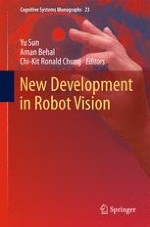
2015 | OriginalPaper | Buchkapitel
Multi-modal Manhattan World Structure Estimation for Domestic Robots
verfasst von : Kai Zhou, Karthik Mahesh Varadarajan, Michael Zillich, Markus Vincze
Erschienen in: New Development in Robot Vision
Verlag: Springer Berlin Heidelberg
Aktivieren Sie unsere intelligente Suche, um passende Fachinhalte oder Patente zu finden.
Wählen Sie Textabschnitte aus um mit Künstlicher Intelligenz passenden Patente zu finden. powered by
Markieren Sie Textabschnitte, um KI-gestützt weitere passende Inhalte zu finden. powered by
Spatial structure, typically dealt with by robots in domestic environments conform to Manhattan spatial orientations. In other words, much of the 3D point cloud space conform to one of three primal planar orientations. Hence analysis of such planar spatial structures is significant in robotic environments. This process has become a fundamental component in diverse robot vision systems since the introduction of low-cost RGB-D cameras such as the Kinect, ASUS and the Primesense that have been widely mounted on various indoor robots. These structured light/ time-of-flight commercial depth cameras are capable of providing high quality 3D reconstruction in real-time. There are a number of techniques that can be applied to determination of multi-plane structure in 3D scenes. Most of these techniques require prior knowledge modality of the planes or inlier scale of the data points in order to successfully discriminate between different planar structures. In this paper, we present a novel approach towards estimation of multi-plane structures without prior knowledge, based on Jensen-Shannon Divergence (JSD), which is a similarity measurement method used to represent pairwise relationship between data. Our model based on the JSD incorporates information about whether pairwise relationships exist in a model’s inlier data set or not as well as the pairwise geometrical relationship between data points.
Tests on datasets comprised of noisy inliers and a large percentage of outliers demonstrate that the proposed solution can efficiently estimate multiple models without prior information. Experimental results shown using our model also demonstrate successful discrimination of multiple planar structures in both real and synthetic scenes. Pragmatic tests with a robot vision system also demonstrate the validity of the proposed approach. Furthermore, it is shown that our model is not just restricted to linear kernel models such as planes but also be used to fit data using non-linear kernel models.